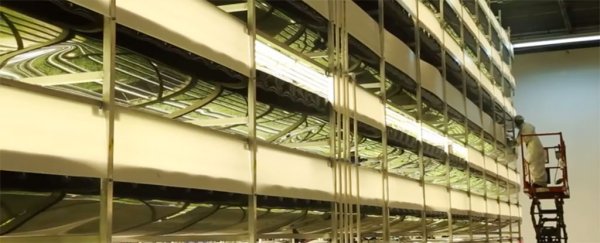New Jersey will host the world's largest vertical farm when it launches later this year, with US-based agriculture startup AeroFarms expected to open its new headquarters in Newark in the coming months.
Set inside a 6,500-square-metre (70,000-square-foot) old steel mill, the new AeroFarms facility is located less than a kilometre from its current 2,800-square-metre site, but the roomier digs will enable significantly greater output of vertically farmed fresh produce.
With towering stacks of farming racks extending some 24 metres (80 feet) high, the company expects to harvest up to 900,000 kilograms (2 million pounds) of leafy greens annually.
But even more impressive than the actual harvest rate is how AeroFarms says it plans to get there. Using a totally indoor, pesticide-free system, the startup grows its produce under low-power LED lighting arrays controlled by an autonomous computer system, specifically tailored to maximise flavour and texture.
The company says this system makes its farms 75 times more productive than a standard agricultural crop in a field.
"Growing outdoors is more challenged than ever before, especially when you layer in the increasing volatility of weather and climate change and issues of food safety and pesticides," AeroFarms' marketing director and co-founder Marc Oshima told Conrad De Aenlle at The New York Times earlier in the year. "We need a new paradigm. Vertical farming gives us control over a lot of these variables."
AeroFarms' crops – including kale, mizuna, arugula (rocket), and watercress – aren't actually planted in soil, but on a reusable cloth sheet made from recycled plastic, and they receive water and nutrients from a mist solution sprayed onto the greens. The company says its technique uses 40 percent less water than hydroponic systems and 95 percent less than field-farming.
The new Newark facility, which will be the largest vertical farm in the world when it opens, was originally scheduled to start business in 2015, but delays have pushed the window back to later in 2016. Media reports suggest that the launch will be imminent.
But while the new AeroFarms HQ might be the biggest vertical farm when it opens, it certainly won't be alone. Interest in indoor and vertical farming systems has exploded all over the world in recent times.
In London, a vertical farming company set up shop in old abandoned World War II tunnels, while Germany is experimenting with miniature vertical farms that grow produce inside supermarkets.
Elsewhere in Europe, a sustainable villages development in the Netherlands is looking at incorporating vertical farms into miniature towns that source their own organic food.
A common theme across all these kinds of initiatives is re-using urban spaces so that fresh produce can be grown and eaten locally, and doesn't need to be moved huge distances between the field and the consumer – with the energy demands of food transport taking a heavy toll on the environment.
Another benefit is the low water and energy footprint of these indoor farming systems, especially when compared to the intensive demands of standard agricultural practices, which have seen the world lose a third of its farmable land in the last 40 years.
"There are situations in dense urban areas where space is highly limited that growing food with artificial lights, stacked vertically, makes sense, especially highly perishable products like sprouts or salad greens where there is an immediate market for them," environmental scientist Stephen J. Ventura from the University of Wisconsin told The New York Times.
"The local-food movement has made people more aware of where their food is coming from and helped create a general trend toward more production in and around cities."
